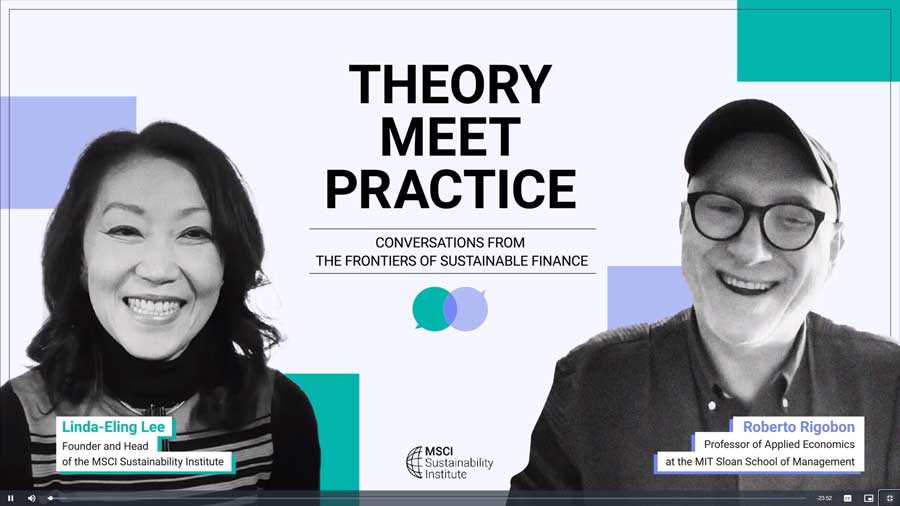Episode 4: Navigating climate transition risk with Marcin Kacperczyk
Are companies lacking an incentive to uphold their climate commitments? The evidence suggests so, says Marcin Kacperczyk, a professor of finance at Imperial College London, who joined me recently on “Theory Meet Practice” to discuss his research into the risks faced by companies and investors in the transition to a low-carbon economy.
Though as many as one-third of companies are falling short of reducing emissions by the amount they’ve pledged to reduce, the impact on their overall value appears to be minimal, Kacperczyk finds in a paper published last year with co-authors Joseph Aldy, Patrick Bolton and Zachery M. Halem.
“
Marcin Kacperczyk shares his desert island paper
What academic paper on sustainable finance (besides one of his own) would Marcin Kacperczyk want with him if stranded on a desert island? Kacperczyk says he would choose something by Martin Weitzman, the late Harvard economist whose pioneering work explored the economic implications of climate change and included calling for a universal tax on carbon.
“He told us quite a lot about the transition of climate into economics,” says Kacperczyk, who says that Weitzman’s work has inspired his own. “His studies are, to me, good examples of the foundational work for thinking about the empirical context of climate finance.”
The authors note that BP, for instance, suffered no negative effects after announcing early last year that it would walk back its previously stated aim of reducing oil and gas production 40% by 2030.
“There doesn’t seem to be a transmission mechanism that says if you fail your commitment, there is some kind of penalty,” observes Kacperczyk, whose research suggests a series of reasons for this reality, potentially explaining why despite an increase in the number of companies pledging to reduce emissions, global greenhouse gas emissions continue to hover near record highs.
Companies that choose to make a climate commitment are the companies that have lower carbon emissions to begin with, Kacperczyk and Bolton have showed, while companies with the biggest challenge in aligning with net-zero are also the companies least likely to commit. “The companies that actually make commitments are not necessarily companies that are the biggest problem to deal with,” explains Kacperczyk, who adds that companies making climate commitments also tend to be “the emissions leaders in their respective industries rather than the laggards.”
If the laggards — those companies producing the most emissions — are not making commitments, an increase in the number of climate commitments won’t necessarily lead to meaningful reductions in global emissions, he notes.
Lessons from the tobacco industry
That’s not to suggest that climate transition risk to companies and investors won’t increase so long as global carbon emissions continue to rise, cautions Kacperczyk. His research analogizes climate risk to the tobacco industry, where companies experienced a massive revaluation following reports by the U.S. Surgeon General in the 1960s that documented the dangers of smoking.
The public-health verdict on smoking triggered waves of repricing that resulted in tobacco companies being revalued at much lower multiples while delivering large returns (because of the risk premium that investors demanded for holding them).
Though Kacperczyk acknowledges the difference between a single industry and a global problem like climate change that affects the entire economy, he sees a potential parallel with climate risk. “There has to be a shift by which investors are going to change the way they price assets, with a particular expectation for the future,” he says. “Because expected returns are about the future, there has to be repricing.”
Pricing transition risk
Climate transition risk is a key driver of what Kacperczyk terms a “carbon premium” demanded by investors, who demand higher returns for holding assets associated with higher carbon emissions. “If two companies are otherwise similar but differ in their emissions, the higher-emission company will typically face a higher cost of capital, about 2-3% more per year,” he explains.
Transition risk, adds Kacperczyk, is shaped by a series of drivers that range from technological progress to policy uncertainty. Companies with more technology options, for example, are going to face lower costs (and, consequently, more pressure) to transition compared with companies that still rely on technologies grounded in fossil fuels.
“That’s where I think this distinction between short term and long term becomes very interesting,” says Kacperczyk, pointing to the knowns for how energy can be produced by solar or wind that enable investors to value those technologies accordingly. “If you think about technologies, paradoxically, we really don’t know much about the long term,” he notes. “We know a lot about the short term.”
Investors, he explains, attach a premium to clean-energy technologies over the short term because of uncertainty that surrounds the long-term outlook. “If we want to actually engage in decarbonization in a meaningful way, I think our best hope is what works now, rather than hoping there is something that potentially is going to rescue us in the future,” Kacperczyk suggests.
Every industry matters
Though some industries have much higher emissions than others, constraining climate change demands a focus across industries, including on both companies’ direct and indirect emissions, says Kacperczyk. The information technology sector doesn’t put much carbon into the atmosphere directly but consumes a vast amount of energy, as do all the products that need to be produced for IT to function, he notes.
The same goes for emissions-intensive industries, says Kacperczyk. “Typically, we think that if you are an oil and gas company, you must be bad, period, but that’s not true,” he suggests, noting the variation in emissions intensity across companies in the energy sector. “What matters is not so much which industry you belong to, but your individual contribution to the emissions,” he says. “I think it’s very important to actually take that into consideration.”


